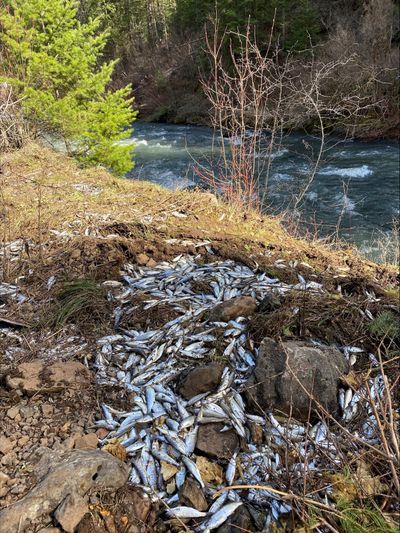100,000 live salmon spilled off a truck in Oregon. Most landed in a creek and lived.

On a recent morning in March, while dew was still on the road, there occurred the salmon smolt mishap of northeast Oregon.
The Oregon Department of Fish and Wildlife said on Tuesday that one of its tankers was in an accident on March 29, resulting in the escape of thousands of live salmon that were being moved as part of a federal and state program to replenish stocks depleted by dams.
The driver, who had minor injuries from the crash, had just left a local hatchery in Elgin, Oregon, in the tanker, which weighed about 80,000 pounds when loaded with water and fish. It was about 10:30 a.m., early enough for there to be dew on the road. After navigating a sharp corner, the 53-foot tanker, which was carrying about 102,000 fish, rolled onto its passenger side, skidded, went down a rocky embankment and flipped onto its roof.
Tens of thousands of live fish were hurled from the truck and swept into Lookingglass Creek or onto its banks. The young salmon, or smolts, lucky enough to drop into the creek are expected to persevere in their migration from the Grande Ronde River to the ocean.
Employees from a local hatchery, members of the Nez Perce Tribe and the Union County Sheriff’s Office came to help and to clean up the fish. They counted the losses.
About 25,525 smolts that were thrown onto the creek banks “were not able to flop down into the water,” Andrew Gibbs, the department’s fish hatchery coordinator for Eastern Oregon, said in an interview on Wednesday.
“But the silver lining for me is 77,000 did make it into the creek and did not perish,” Gibbs said. “They hit the water running.”
In his 10 years on the job, Gibbs said, the accident appeared to be a rarity for the state and federal program, which moves smolt-stage salmon from Oregon’s hatchery to stock populations affected by dams built on the lower Snake River.
In northeastern Oregon, such efforts have been ongoing since 1982 at the Lookingglass Hatchery in Elgin, about 300 miles east of Portland. The hatchery was set up to spawn and incubate eggs. Smolts are transported between freshwater and saltwater using tankers and barges.
“It is kind of a fish taxi,” Gibbs said.
The state-run hatchery is one of 33 in Oregon that reinforce stocks of salmon, which are used for food and in sports fishing. The department said in its statement that the smolts that were lost made up about 20% of the total fish that state hatcheries planned to release into the Imnaha River this year.
The accident interrupted what is already a tortuous journey in the smolt life cycle, in which they encounter predators, fishing activity and habitat alterations that affect migrations, including the dams. As adults, they die after spawning.
On the morning of March 29, the plan was for the smolts, which were about 18 months old, to be taken by tanker on a three-hour drive to a pool constructed at the Imnaha River. There, they were meant to acclimate for a few days before their 650-mile journey through the Snake and Columbia rivers to the Pacific Ocean.
“They hitch a ride on the spring runoff, tail first, so there is less resistance,” Gibbs said. “That way, they can conserve energy until they get to the ocean.”
After up to three years of ocean foraging, the salmon will journey in reverse, using a kind of scent memory of the Imnaha River to guide them.
“They kind of smell their way back,” Gibbs said. “It’s an incredible life history.”
This story originally appeared in the New York Times.
